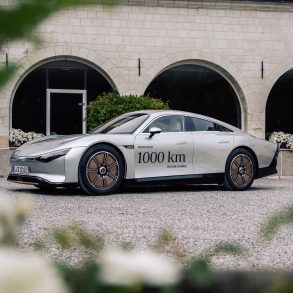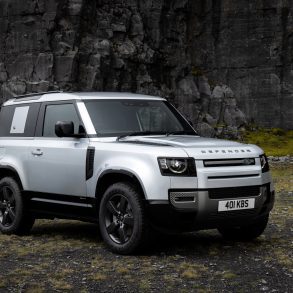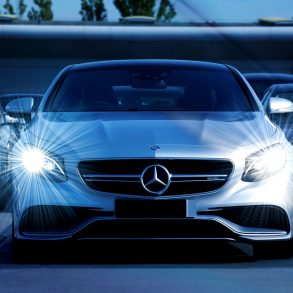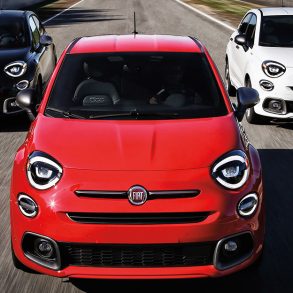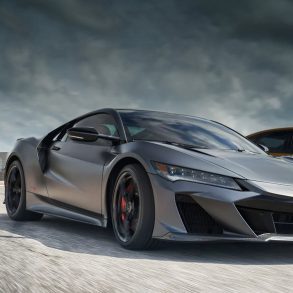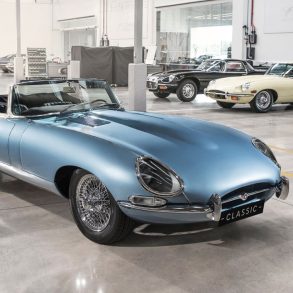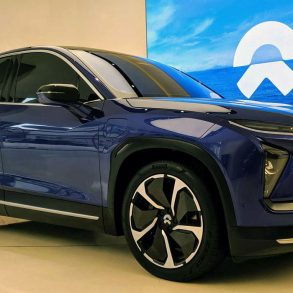The Geneva International Autoshow featured many premieres, and some of the most important product launches are in the minicar segment. In the coming months, a handful of new A-segment models will hit the European market, and the competition will be fiercer than ever. These cars have made great strides in “growing up”: departing from their budget roots and promising improved handling and comfort.
Renault Twingo
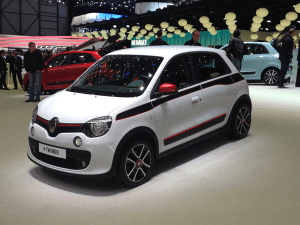
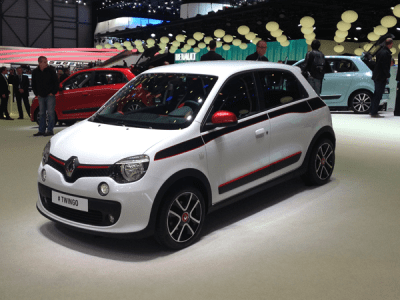 Renault has just launched the new, third generation Twingo, a car that shares its platform with the upcoming Smart Fortwo and Forfour. That means its engine is placed in the rear, under the luggage compartment, and it is also rear-wheel drive.
Renault has just launched the new, third generation Twingo, a car that shares its platform with the upcoming Smart Fortwo and Forfour. That means its engine is placed in the rear, under the luggage compartment, and it is also rear-wheel drive.
According to Renault head of design Laurens Van den Acker, the concept of a rear-engined, rear wheel drive citycar makes sense for a number of reasons: first, it helps create a spacious interior, as they have been able to make the car 10cm (4 inches) shorter than the outgoing model, while adding 22cm (8 inches) of space inside. This does come at the cost of luggage space, as the floor of the boot has been raised. Secondly, because there is no engine between the front wheels, the wheels can be turned in further, thus creating a smaller turning circle, which is ideal for city driving. And finally, the all-rear layout should be a recipe for “fun to drive”. That is true indeed, if done right (evidence no. 1: Porsche 911, or basically every good sports car), but it could just as well mean absolutely disastrous driving dynamics if done wrong (evidence no. 2: Smart Fortwo). Let’s hope the chassis technicians from Renault Sport have been asked to take care of the handling, so it will drive as good as it looks.
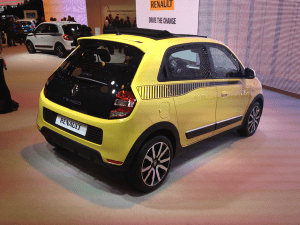
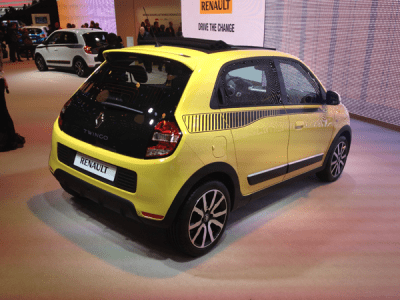 Those looks are inspired by the early ‘80s Renault 5 Turbo, but it undeniably also shares some resemblance to the Fiat 500. Regardless of which car the designers have studied to get into the right mood, it is a big step forward from the somewhat anonymous previous generation, which was not worthy to share its name with such an iconic predecessor. True to its roots, the Twingo will be available with an optional full-sized sliding canvas roof.
Those looks are inspired by the early ‘80s Renault 5 Turbo, but it undeniably also shares some resemblance to the Fiat 500. Regardless of which car the designers have studied to get into the right mood, it is a big step forward from the somewhat anonymous previous generation, which was not worthy to share its name with such an iconic predecessor. True to its roots, the Twingo will be available with an optional full-sized sliding canvas roof.
Citroën C1 / Peugeot 108 / Toyota Aygo
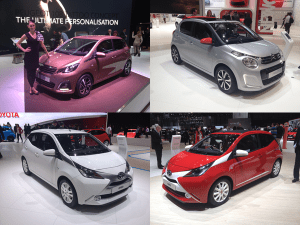 The new generations Toyota Aygo, Citroën C1 and Peugeot 108 are again a triplet of cars, but unlike their first generations, the new cars are more distinguishable from each other, especially the Aygo, which separates itself from its French siblings with an entirely different rear end and ‘double-bubble’ roof. The Peugeot and Citroën are similar with the exception of their noses, but these noses give the cars have totally different characters. Whereas the Japanese family member looks more frivolous and playful, the Peugeot has a more sensible and serious attitude, and the Citroën looks almost cheeky with its “facial expression” of a blinking smiley 😉 The Kolin triplets are 15-20cm (6 to 8 inches) shorter than the Twingo, the VW-Group triplets and the new Suzuki Celerio.
The new generations Toyota Aygo, Citroën C1 and Peugeot 108 are again a triplet of cars, but unlike their first generations, the new cars are more distinguishable from each other, especially the Aygo, which separates itself from its French siblings with an entirely different rear end and ‘double-bubble’ roof. The Peugeot and Citroën are similar with the exception of their noses, but these noses give the cars have totally different characters. Whereas the Japanese family member looks more frivolous and playful, the Peugeot has a more sensible and serious attitude, and the Citroën looks almost cheeky with its “facial expression” of a blinking smiley 😉 The Kolin triplets are 15-20cm (6 to 8 inches) shorter than the Twingo, the VW-Group triplets and the new Suzuki Celerio.
Suzuki Celerio
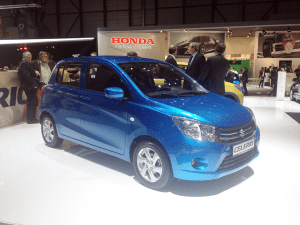
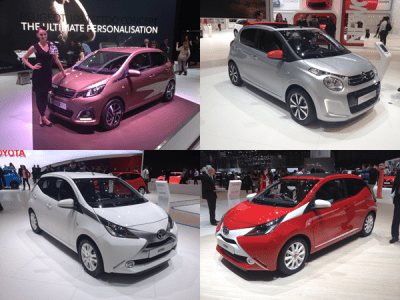 The Celerio is the replacement to the Alto, and is also launched in Geneva this week. The Celerio is bigger than the Alto and promises class-leading interior space and luggage capacity. Suzuki also claims it has best-in-class fuel economy. This should appeal to the sensible and thrifty minicar buyer, the same people who used to buy the Alto. The Celerio looks and feels more like a budget car compared to the other new entrants in the segment, which have made great inroads in exterior and interior design. A Nissan version, as the Pixo was a rebadged Alto, is not planned for the Celerio.
The Celerio is the replacement to the Alto, and is also launched in Geneva this week. The Celerio is bigger than the Alto and promises class-leading interior space and luggage capacity. Suzuki also claims it has best-in-class fuel economy. This should appeal to the sensible and thrifty minicar buyer, the same people who used to buy the Alto. The Celerio looks and feels more like a budget car compared to the other new entrants in the segment, which have made great inroads in exterior and interior design. A Nissan version, as the Pixo was a rebadged Alto, is not planned for the Celerio.
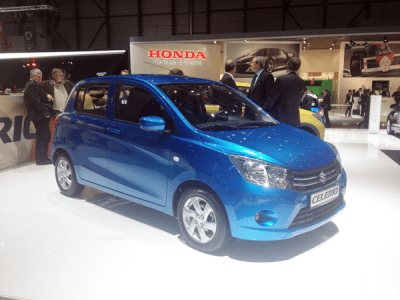 The Toyota-PSA triplets should easily be able to regain the segment sales crown (when combined), and the Twingo is expected to do better than its relatively slow-selling predecessor, despite increased competition from cars like the new generation Hyundai i10 (a few months on the market now) and the VW-Group triplets. I think it has enough qualities and distinctive character to set it apart from the mass. Provided it’s as fun to drive as Renault promises. The Alto has never challenged for the segment leadership, and Suzuki hopes the Celerio will move it up a notch on the sales ladder, but I think it should be lucky to peak at more than 50.000 annual sales. Not that it does much wrong, but it just doesn’t tickle your soul.
The Toyota-PSA triplets should easily be able to regain the segment sales crown (when combined), and the Twingo is expected to do better than its relatively slow-selling predecessor, despite increased competition from cars like the new generation Hyundai i10 (a few months on the market now) and the VW-Group triplets. I think it has enough qualities and distinctive character to set it apart from the mass. Provided it’s as fun to drive as Renault promises. The Alto has never challenged for the segment leadership, and Suzuki hopes the Celerio will move it up a notch on the sales ladder, but I think it should be lucky to peak at more than 50.000 annual sales. Not that it does much wrong, but it just doesn’t tickle your soul.

